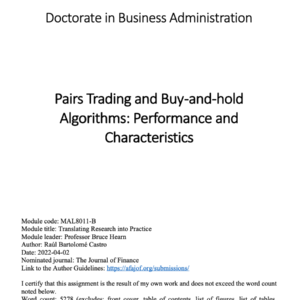Pairs trading is an established trading strategy for hedge funds and alike. It is a relatively simple trading strategy that presents two distinctive phases. First, it identifies pairs of securities that are related using one year of historical data. Second, it trades for six months the underlaying securities of the pairs whenever the spread of the pairs exceeds certain value, usually two times the historical standard deviation.
In my latest manuscript I conduct an empirical research of pairs trading algorithm to study its behaviour and fundamental characteristics. Likewise, I compare the results with the standard benchmarking Buy-and-hold strategy using SPY contact.
I use QuantConnect as the trading platform for the evaluation of the algorithms. I do up to 272 simulations of each algorithm with the support of various scripts in Phyton, which helps in the automation process of data acquisition and data processing.
You can find the complete study in the download section. I find particularly interesting the conclusions for retail and institutional investors:
Retails investor might find little benefit of pairs trading and buy-and-hold might be better solution thanks to higher returns and consistency. However, astute investors might try to obtain the benefit of both algorithm by switching from buy-and-hold to pairs trading in times of turbulent markets using VIX as fear indicator. Institutional investors can include pair trading in the pallet of algorithm; the market neutrality, low volatility, and good performance during disruptive markets are attractive characteristics. Nevertheless, it is not advisable to use pairs trading as standalone strangely but a combination with other trading algorithms.



